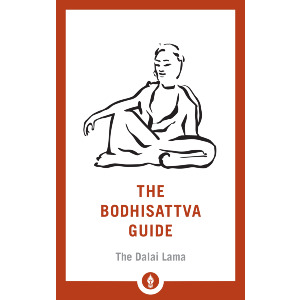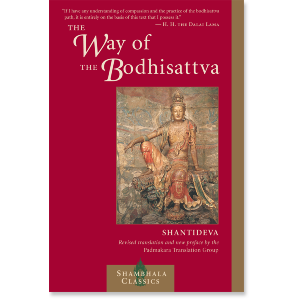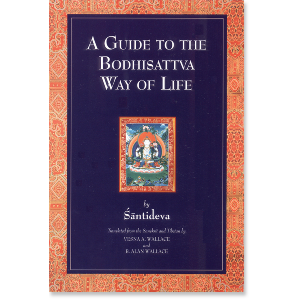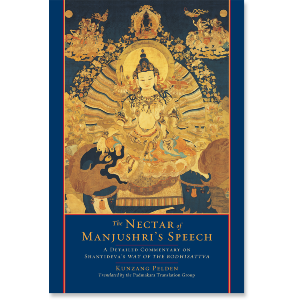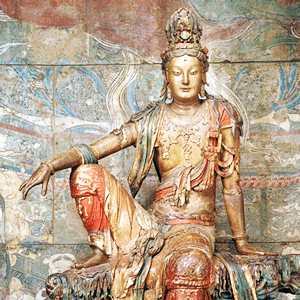
Many Kinds of Wisdom
1.
All these branches of the Doctrine
The Enlightened Sage expounded for the sake of wisdom.
Therefore they must cultivate this wisdom
Who wish to have an end of suffering.
There are many kinds of wisdom. There is, for example, the relative type of wisdom gained through the study of the five major traditional sciences. There is also the wisdom of working for the benefit of others. When Shāntideva says here that “all these branches of the Doctrine were expounded for the sake of wisdom,” he is referring to the wisdom that is the realization of emptiness, the true nature of things. This is absolute wisdom.
In order to realize emptiness, we do not actually need the first five pāramitās, and they are not even essential for developing clear insight for vipashyanā. But as we shall see, they are necessary if we wish to benefit other beings.
Nāgārjuna says in the Seventy Verses on Emptiness:
Thus the Buddha said:
All things arise from causes and conditions;
To view them as real is ignorance
From this arise the twelve interdependent links.
Further, it is said in the Four Hundred Verses:
The seed of existence is consciousness;
Phenomena are the field of consciousness.
If we see the nonreality of things,
We destroy the seed of existence.
These passages can be interpreted in various ways, but according to the tradition of Chandrakīrti, which is the one to which Shāntideva adhered, the teaching of Nāgārjuna and his lineage says that to cling to the self as a real entity is to be ignorant, and the ignorance of believing that phenomena truly exist constitutes one of the twelve interdependent links. This gives rise to saṃsāric existence, which in turn is another of the twelve interdependent links.
The second passage states that the seed of this saṃsāric existence is the kind of consciousness that has objects, or phenomena, as its field of experience. If these objects are understood to be devoid of ultimate reality, this seed of existence is undermined, and it is completely destroyed when the wisdom of realizing that phenomena are without true existence is perfectly developed.
All schools of Buddhism, with one minor exception, agree that the notion of a personal self, the “I,” is dependent upon the five aggregates. They reject the belief in a self that exists independently of these aggregates. The theory of selflessness, however, goes much further than the denial of the personal “I.” For one must aim to realize that all phenomena are empty, or devoid of true existence, and have in fact a mode of being that is extremely subtle.
As we have said, when we see that phenomena or objects of consciousness are devoid of any true entity, the seed of existence is destroyed. The reverse of this understanding is to cling to the belief that things have a solid reality, and this is the definition of ignorance.
Freedom from Negative Emotions
It is a mistake to believe that those who practice the lower vehicles are unable to free themselves from negative emotions and thereby attain liberation from saṃsāra. Indeed, to think like this is a major breach of the Bodhisattva precepts. When those who follow the paths of the Shrāvakas and Pratyekabuddhas become Arhats, they completely rid themselves of the obscurations engendered by negative emotions. They must also have a realization of emptiness, otherwise they would not be freed from samsāra. The wisdom of understanding emptiness in fact gives rise to three types of enlightenment: that of the Shrāvakas, that of the Pratyekabuddhas, and that of the Bodhisattvas.
When Shāntideva says, “All these branches of the Doctrine / The Enlightened Sage expounded for the sake of wisdom,” he is referring to the wisdom of the Bodhisattvas and not to the mere insight into emptiness cultivated by the Shrāvakas and Pratyekabuddhas as they progress upon their respective paths. What, then, is special about the Bodhisattvas’ wisdom? Why do they meditate on emptiness? Bodhisattvas aim to rid themselves not only of the obscurations created by negative emotions but also of the obscurations that are obstacles to knowledge. They must free themselves from the former before they can deal with the latter.
Nevertheless, it may be said that in certain circumstances negative emotions provide the occasion for a good result, as when the cherishing of others arises through desire. As the proverb says, “Foul sewage from the city of Serkya fertilizes the fields of sugarcane.” In fact, however, the Bodhisattvas’ real enemies, and the greatest hindrances in their work for others, are the obscurations that veil omniscience. But since these consist in the residual traces left by negative emotions, it follows that the latter must be abandoned before the obstacles to knowledge can be removed.
Thus, when Bodhisattvas meditate on emptiness, their aim is mainly to dispel these obstacles to knowledge. In order to do this, it is not enough simply to have an intellectual understanding of the subtle nature of things. The wisdom that dispels these obscurations must be supported by such practices as generosity and the other pāramitās. The Buddha taught these different practices so that Bodhisattvas could attain the clear insight through which they might dispel obstacles to knowledge and then work for the benefit of others.
Generating Wisdom to Put an End to Suffering
In talking about generating wisdom to put an end to suffering, Shāntideva is referring to the suffering of all beings. After all, this text is about the activities of the Bodhisattva, and have we not only recently discussed what is wrong with cherishing oneself and why it is important to think of others?
When generosity and so forth are practiced as pāramitās, are practiced with an understanding that the subject, object, and the action itself are all devoid of true existence, these acts become very profound and completely transcend ordinary generosity and so on.
We should note that Shāntideva talks about generosity first and places the topic of wisdom only at the end. He had a reason for this. In the Compendium of All Practices, just before beginning his exposition of emptiness, he shows with numerous quotations from the sūtras that the Buddha himself, before broaching the same subject, would speak about the unattractiveness and impermanence of phenomena and about the nature of suffering. One might almost think that the world of phenomena was the main subject of his teaching, for it was only in conclusion that he would say that things have no true, objective existence. There was, however, an extremely important reason for his proceeding in this way. To begin with, he would discuss the positive and negative aspects of things, laying the ground for a clear understanding of the unfailing functioning of relative truth, according to which things do indeed exist. It was on the basis of their relative existence that the Buddha explained that phenomena are empty by their nature. Only where there is a basis is it possible to assert emptiness. As it is said: “Form is emptiness; emptiness is form.” Because there is form, we can talk about its nonexistence. If there were no form, there could not be emptiness of form. As there are phenomena that we can talk about as being empty, we say there is a basis for emptiness. Without that basis, emptiness would be inconceivable.
An explanation of the practices of the first five pāramitās, starting with generosity, gives us a clear view of the basis for emptiness.
When, for example, we practice generosity to remove for ourselves and others all suffering due to poverty, we are cognizant of the relative truth of cause and effect. When it is subsequently explained that, in absolute truth, all this is actually devoid of real existence, we are already firmly grounded in relative truth and are thus protected from erring into the philosophical extremes of nihilism or eternalism.
2.
Relative and ultimate,
These the two truths are declared to be.
The ultimate is not within the reach of intellect,
For intellect is said to be the relative.
A distinction is made, with regard to knowable things, between the relative (conventional) and the absolute (ultimate) truth. According to the root text, absolute truth cannot be perceived by the intellect.
As we find in the Prajñāpāramitā:
The pāramitā of wisdom is inconceivable, inexpressible, and indescribable.
It is not born; it does not cease; it is like space.
Only the awakened mind can comprehend it.
Before the Mother of all the Buddhas, I bow down!
Again, the Vajra Cutter Sūtra says:
The absolute nature of the Buddhas,
The absolute body of the spiritual guides,
Cannot be understood by the intellect.
The reason for this, as Shāntideva says, is that the intellect is something that exists on the level of relative truth. However, the interpretation of this point is delicate, because later in the text we shall read about another kind of intellect and intelligence. Shāntideva continues:
3.
In light of this, within the world, two kinds of people are observed:
Those with yogic insight and the common run of people.
In this regard, the views of ordinary folk
Are undermined by yogis who themselves are in the world
4.
(Within whose ranks
The lower, in degrees of insight, are confuted by the higher)
By means of the examples that the yogis and the worldly both accept.
And for the sake of the result, analysis is left aside.
When the text speaks about insight or intelligence, it is referring to the understanding of lack of true existence. In the use of discriminating wisdom to analyze phenomena, the different schools gain different levels of this understanding, and those with more advanced philosophical views confute those with less advanced views.
Types of Discriminating Wisdom
Again, there are two kinds of discriminating wisdom. One discriminates things concerning relative truth, and the other discriminates things concerning absolute truth. Here in the text, insight, or intelligence, refers to discriminating wisdom that analyzes the absolute nature of things and not intelligence in its more general sense concerning relative phenomena. And if the verse is considered in terms of the profound path and the vast path, it is the profound path that is referred to.
It is said in the Entrance to the Middle Way: “One who is at the level further to go has superior intelligence.” When a Bodhisattva reaches the seventh level, which is called further to go, his intelligence surpasses that of a Shrāvaka or Pratyekabuddha. Until then, Bodhisattvas on the first level upward surpass the Shrāvakas and Pratyekabuddhas because of their family, not because of the power of their intelligence, or their understanding of emptiness. Only when they reach the seventh level is their intelligence superior. It is also said that at this point they surpass the Shrāvakas and Pratyekabuddhas in their ability, in a single instant, to enter into and arise from the concentration of perfect cessation.
When Shāntideva says that absolute truth cannot be perceived by intellect, he is referring not to the intelligence that discerns absolute truth but to the obscured intelligence that conceives the dichotomy of subject and object. Absolute truth is something that we have to experience with a mind free of concepts and in which there are no such dualistic notions. Relative truth is what is perceived by the conceptual, dualistic intelligence.
Absolute and Relative Truths
The non-Buddhist traditions of ancient India also talked about absolute and relative truths. The Sāṃkhyas, for example, regarded the primal substance as absolute truth, and the rest of the twenty-five objects of knowledge (such as the Self) as relative truth. Even between the different Buddhist schools—the Vaibhāshika, Sautrāntika, Chittamātrin and Mādhyamika—the two truths are explained in slightly different ways.
The term relative is sometimes called an obscuring truth and sometimes a conventional truth, depending on the context. And absolute truth can also have many different meanings. The Treatise on the Center and Extremes speaks of absolute absolute truth, practiced absolute truth, and attained absolute truth. Again, in the supreme Mantrayāna one speaks of the absolute luminosity. Moreover, to explain the specific practices of the Mantrayāna, the two truths are explained in different ways. For example, the illusory and temporary aspect of phenomena is related to relative truth, while their aspect of primordial continuity is related to absolute truth.
So when we talk about the absolute truth, we should always do so with reference to the context, whether Sūtrayāna or Mantrayāna, and if Mantrayāna, to the particular tantra. We should then gain a precise understanding of absolute truth within that context. This is very important. If we try to apply only a general understanding of absolute truth to some specific text, we can get very confused.
It is said in the Root Verses of the Middle Way that the teachings of the Buddha rely on the two truths: the truth of the relative world and the supreme, absolute truth. This is explained in detail in the Entrance to the Middle Way, which says that, as all phenomena are perceived both correctly and mistakenly, we apprehend their nature in two ways. What is correctly perceived is absolute truth, and what is perceived incorrectly is relative truth. This refers to the findings of nonconceptual experience, related to absolute truth, and those of conceptual analysis, related to relative truth. It is on the basis of these that we establish our understanding of emptiness. But here we are only talking about the nonconceptual experience of the absolute truth. With this exception, the ways of distinguishing the truths are the same as in the Entrance to the Middle Way.
Why do we need to realize emptiness? We do not wish to suffer, and we know that the root of suffering is the untamed mind. Because the mind perceives and understands things mistakenly, negative emotions arise and the mind is never at peace. This is why we suffer. To avoid this, we must develop the unmistaken mind, the intelligence that perceives the true nature of phenomena. Mistaken perception arises because we fail to see things as they are.
Much of what we perceive we perceive in a mistaken way, seeing things not as they truly are. This is how we become deluded. To avoid this, we should not accept our perceptions just as we experience them. It is very important to analyze and investigate whether we are seeing things as they truly are. We should ask ourselves what our perceptions are masking. If we do this, an understanding of the two truths will arise in our minds.
All we perceive—mountains, houses, and so on—affect us in one way or another. We need to investigate their real nature. Our perceptions, and the positive and negative aspects that we attribute to them, constitute relative truth. Relative truth is what we find when we experience the multiplicity of phenomena in a relative way, without going any further in analyzing their nature. The findings of the analysis by the conventional mind constitute relative truth.
If, according to absolute truth, things have no true existence, why do we speak of relative truth as truth? Because it is true for the perceiver. It is true for the mind clouded by ignorance, which believes in the reality of its perceptions. As the Entrance to the Middle Way says, that which is altered and obscured by ignorance and is perceived as real is called relative truth.
For which mind is the multiplicity of phenomena true? It can only be the confused ignorant mind that believes that things exist objectively. The true nature of things is obscured by the mind’s ignorant clinging to things and to the way they function. Thus, relative truth is based on the findings of the mind that examines things in a conventional way. If we analyze further and try to see the true nature of phenomena, we can find the ultimate nature of reality. Here we distinguish between the way things appear (relative truth) and the way they are (absolute truth), which is what is perceived by the undeluded mind.
There are two ways of approaching absolute truth: a positive idea of it can be gained through listening, reflecting, and meditating, and an understanding of it in terms of negation can be gained by analysis. It stands to reason that if one can find through analysis anything that truly exists, one should also be able to find it through listening, reflecting, and meditating. But the fact is, what one can find through listening, reflecting, and meditating cannot be found by analysis. The absolute nature, for example, is something that can be experienced through listening, reflecting, and meditating. When one investigates the nature of the individual and of all phenomena, one finds that their nature is emptiness. This emptiness is an absolute truth that is apparent to the mind. One can see it with one’s awareness. Once it has been experienced, it is not necessary to demonstrate it again. By referring to one’s experience of this nature, one can recall it. Its existence is true, and one does not have to rely on argument to prove that it exists. So when one has some confidence that no phenomena truly exist, one does not need to have this explained again or to repeat the investigation. This absolute nature that is established through listening, reflecting, and meditating is something we can experience.
The Emptiness of Emptiness
However, when one looks for this absolute nature or emptiness, and tries to find where it is, one cannot find it. Its nature is nonexistent. When one makes the absolute nature (that one experienced through listening, reflecting, and meditating) the object of analysis, one cannot find it. This is why it is called nonexistent by nature. To take an example, we can say that a vase has the nature of emptiness, but when we look for that emptiness, it is nonexistent. All we can find is the emptiness of emptiness, but we cannot find emptiness. What has been found by experiencing it through listening, reflecting, and meditating cannot be found through such analysis.
This is an important point. The understanding of absolute truth that comes from listening, reflecting, and meditating is something that exists and can be experienced. But in the absolute truth that appears through the analysis even of emptiness itself, there is nothing that exists.
This has been excerpted from The Bodhisattva Guide: A Commentary on The Way of the Bodhisattva.
Related Books
$12.95 - Paperback
$16.95 - Paperback
A Guide to the Bodhisattva Way of Life
$16.95 - Paperback
The Nectar of Manjushri's Speech
$39.95 - Paperback
$49.95 - Digital Audio
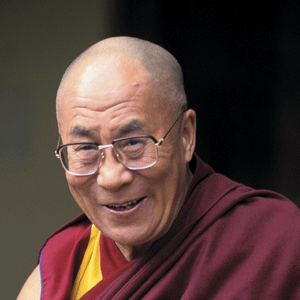 His Holiness the Fourteenth Dalai Lama is considered the foremost Buddhist leader of our time. See more about him here.
His Holiness the Fourteenth Dalai Lama is considered the foremost Buddhist leader of our time. See more about him here.


